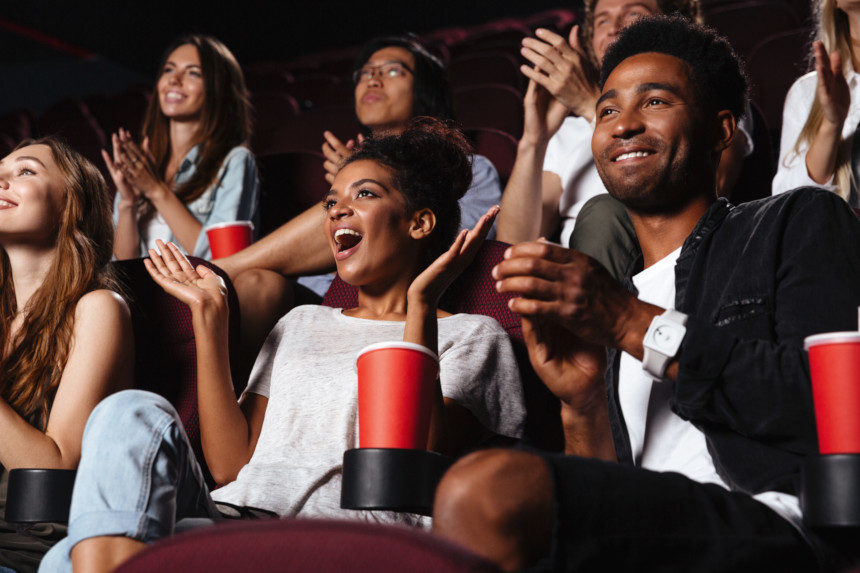When the trailer for Thor: Love and Thunder landed online this week, it was viewed 209 million times in just 24 hours. According to Variety, that makes it the fourth-most viewed trailer in its first day, trailing only three other Marvel films. Apart from inspiring the question, “When did we start tracking trailer views?”, that statistic points to a phenomenon that’s actually been growing for many years: the trailer to an anticipated film has become an event in itself. How did we get here? To find out, we have to go back to the beginning of cinema itself.
Nils Theodore Granlund held a job that’s common today, but was rather new in 1913. He was publicist for Loews Theatres, the chain of movie houses that was launched by Marcus Loew in 1904. As founder of both the chain and MGM Studios, Loew knew a thing or two himself about getting people to talk. But his point man was Granlund, and nine years into the business, he had a new idea. Granlund oversaw a short film to promote The Pleasure Seekers, an upcoming movie. By giving the audience a taste of the new film in a few scenes, Granlund hoped to drive ticket sales. Initially, the Loews theatres put the preview on after the feature presentation; that earned the new sneak peek the nickname “trailer,” as it trailed the actual movie. That was soon deemed ineffective, because audiences that were unfamiliar with the practice would simply leave at the close of the feature. The trailers were soon switched to run ahead of the actual movie.
The original trailer for Casablanca (Uploaded to YouTube by Movieclips Classic Trailers)
By 1920, the various movie studios all started running their trailers through one entity: the National Screen Service. The NSS made and sent out movie trailers for everyone. They fell into a sort of house style that’s recognizable today by their continual use of large print captions on screen (THRILLING DANGER! or SCARY CHILLS! for example). The NSS also standardized the size of movie posters to the familiar 36” x 24” dimensions of today. In the 1960s, studios and individual filmmakers began to take back the task of making trailers, resulting in a variety of styles creeping in to the previews.
So when did moviegoers start showing up mainly for the trailers? Or more to the point, for a specific trailer? Scott Mendelson has a pretty good idea. Mendelson covers the film industry for Forbes, and can plant a flag for sought-after trailers to 1989. Mendelson says, “I would argue that Batman was the first trailer where folks went to the theater just to see the preview.”
The original Batman (1989) trailer (Uploaded to YouTube by Movieclips Classic Trailers)
At time, the making of 1989’s Batman was a magnet for controversy. Not only was it going in a darker direction influenced by two huge 1980s DC Comics hits written by Frank Miller (The Dark Knight Returns and Batman: Year One), the film surprised fans by casting Michael Keaton as Bruce Wayne/Batman. Keaton, primarily known for comedic roles at the time, made some fans curious and some flat-out angry. While the casting Jack Nicholson as the Joker was universally hailed, Keaton had more to prove. Producer Jon Peters decided to confront the issue head on by pushing out a trailer that offered very little of the score and didn’t even have a cohesive narrative thread. However, the look that director Tim Burton was giving the new movie drew fans to the theater months before the film arrived in full.
Mendelson has actually written about the concept of the “event trailer.” One of the major previews was 1994’s The Lion King. Set up to run before the 1993 Disney movie The Three Musketeers, that trailer was something different: it showed an entire segment of the film itself. Mendelson wrote, “Unlike a conventional trailer, Disney decided to tease their Hamlet meets Bambi in Africa epic by showing off the stunning ‘Circle of Life’ prologue.” The trailer played the entire song and opening, all the way through Baby Simba getting hefted into the sunlight by Rafiki, before going a smash cut to the title card.
The first trailer for Star Wars – Episode I: The Phantom Menace (Uploaded to YouTube by Star Wars)
There were other trailers in that decade that could qualify as events (Mendelson points out 1992’s Batman Returns, 1993’s Jurassic Park, and 1998’s Godzilla, which ran a marketing campaign that largely obscured full shots of the American design, provoking added interest; there was also 1995’s Independence Day Super Bowl ad, which received widespread attention). But it’s hard to think of a trailer that was more of an event than 1999’s teaser for Star Wars – Episode I: The Phantom Menace. It’s strange to consider now given Star Wars’ current pop culture ubiquity, but there was a 16-year span between 1983 and 1999 where Star Wars was completely absent from theaters. Sure, there were a couple of live-action made-for-TV Ewok films on ABC in the ’80s, and there were a couple of cartoons, but the only thing really keeping that flame alive was a series of novels that kicked off in 1991. When word got out that George Lucas was going back to Star Wars, the hype was huge. After re-releasing the original trilogy with new scenes and remastered effects for a theatrical run in 1997, the stage was set for an all-new trilogy.
The original Lord of the Rings teaser trailer (Uploaded to YouTube by Forever Cinematic Trailers)
The first teaser trailer went out ahead of Enemy of the State and Rugrats: The Movie in theaters before getting shown on MTV. A few weeks later, a plot-illuminating full trailer ran in front of the famously terrible video game adaptation Wing Commander in March of 1999. This writer can attest that people bought tickets to that film just to see the trailer and leave (I stayed; the ones that left were right). However, by 2001, theaters were catching on to this trailer-and-exit strategy. Regarding the highly anticipated first glimpse of Lord of the Rings, Mendolson says, “I remember signs in theaters in early 2001 posting that audiences paying to see Thirteen Days would not get a refund if they tried to walk out after the first Lord of the Rings teaser played.”
The first trailer for Thor: Love and Thunder (Uploaded to YouTube by Marvel Entertainment)
2005 changed the trailer game forever. While trailers had been making online debuts for a while, 2005 saw the advent of YouTube. That platform’s popularity and general dominance in the online video world has made it the go-to place for “trailer drops” for the last several years. Deployment strategies run the gamut from strictly announced dates and times for new reveals to the sudden-drop-let-it-go-viral approach that the Marvel Cinematic Universe has taken in recent years. The Marvel machine knows the value of having the trailer suddenly pop up online and letting social media do the work of spreading it.
So why does America seem to like trailers so much? Sure, you can argue that a lot of these films have strong, pre-sold audiences that are eager for even the smallest new bit of footage, information, or entertainment. There’s also, particularly for trailers that run in the theater, a bit of a communal shopping experience; you can see the trailer and lean over to the person next to you and discuss what you liked, whether you’re interested, or if it’s a straight-up “no.” But one of the most likely reasons is that trailers, especially well-executed ones, are little windows of a promise for excitement. A solid trailer can make you happy by suggesting the possibility that a good time is just around the corner. It’s a couple of minutes of hope, and that can’t possibly be bad. And even if a trailer doesn’t deliver, there’s no need to worry. There’s always another one ready to drop.
Featured image: Shutterstock
Become a Saturday Evening Post member and enjoy unlimited access. Subscribe now




Comments
Just a reminder: any posts with name-calling, insulting language, profanity, etc. are going to get deleted. Which one just did.
As to Mr. Prudy and Crespo’s comments here: It’s fine to have your opinions. But you’ll note that the reach of the Thor trailer prompted articles at a number of venues. It wasn’t just us. Additionally, in the past few months, I’ve written about:
The Godfather: https://www.saturdayeveningpost.com/2022/03/the-godfather-turns-50/
The odd recurrence of Cheaper By The Dozen: https://www.saturdayeveningpost.com/2022/03/the-curious-immortality-of-cheaper-by-the-dozen/
Cabaret: https://www.saturdayeveningpost.com/2022/02/50-years-ago-cabaret-stormed-the-screen/
Dirty Harry: https://www.saturdayeveningpost.com/2021/12/dirty-harry-clint-eastwoods-brutal-cop-turns-50/
The Evil Dead, which also incidentally got the Coen Brothers started: https://www.saturdayeveningpost.com/2021/10/40-years-ago-the-evil-dead-changed-film-for-good/
The history of Tarzan in film: https://www.saturdayeveningpost.com/2021/08/a-brief-history-of-tarzan/
It’s totally fine if you don’t like something else, but we’re going to reserve the right to talk about the biggest family of films in the culture for the past couple of decades. Thanks for reading.
Movie trailers still have their place for productions worth watching, and those are only going to be found on the likes of Netflix and Starz. The trailers for “Gaslit” premiering tonight on Starz is an excellent, current example. I’m looking forward to it, and Jonathan, I think you will too.
I really agree with all of your comments, and gave up on theatrical releases a long time ago for those very reasons. From what I’ve observed, the writer’s only preference in movies seem to be the kind you mentioned, which indeed is what he wrote about again, above. This is just the latest of too many he’s done on this genre.
Today’s movie trailers in the theater are what they have been for years. They’re one of the reasons movie theaters themselves are on the way out. The trailers preceding the actual film are so loud, long and horrible it’s unbelievable. They are all aimed at the same nerdy, teenage boy crowd with the mentality and attention span of a flea with action, pyrotechnics and all the other predictable constant overstimulation staples used. Star Wars whichever, Harry Potter whatever, Lord of the Rings, DC this, Marvel that. Same ingredients; like trying to tell one white or silver sedan and SUV from another, or any crap current songs from each other. All 3 of these categories, for decades.